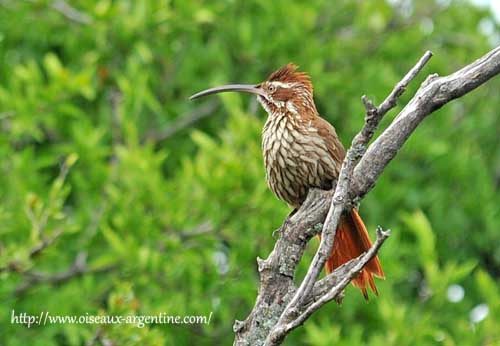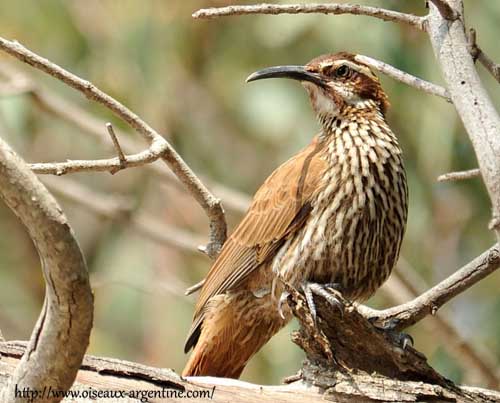
Fr: Grimpar porte-sabre
All : Degenschnabel-Baumsteiger
Esp: Trepatroncos Chinchero
Ital : Rampichino becco a scimitarra
Nd : Sabelmuisspecht
Sd : Sabelnäbbsträdklättrare
Port : Arapaçu-platino
Photographers :
Philippe et Aline Wolfer
GALERIE
Text by Nicole Bouglouan
Sources :
HANDBOOK OF THE BIRDS OF THE WORLD Vol 8 By Josep del Hoyo-Andrew Elliott-David Christie - Lynx Edicions - ISBN: 8487334504
BirdLife International (BirdLife International)
Arthur Grosset's Birds (Arthur Grosset)
The Cornell Lab of Ornithology – Neotropical birds
Scimitar-billed Woodcreeper
Drymornis bridgesii
Passeriforme Order – Furnariidae Family
BIOMETRICS:
Length: 29-35 cm
Weight: M: 76-90 g – F: 87-110 g
DESCRIPTION:
The Scimitar-billed Woodcreeper is the unique member of the genus Drymornis. This species could be ancestral to all woodcreepers. Unlike all other member of the family Dendrocolaptidae, this one has more terrestrial behaviour.
The adult has cinnamon-brown back and wing coverts, darker brown flight feathers, and rufous-chestnut tail and rump.
The underparts are reddish-brown, heavily streaked white. Each streak is bordered with brown, and they are broader on breast and body sides, much narrower on belly, vent and undertail-coverts.
On the head, we can see in both sexes conspicuous white supercilium and moustachial stripe, whereas face and cheeks are dark rufous. Forehead and crown are dark rufous-chestnut, and the nape is slightly paler. The chin is white.
The long, down-curved bill is dark brown to blackish with paler lower mandible. The eyes may vary from yellowish to pale greyish-brown to darker brown. Legs and feet are horn-coloured, grey or blackish.

Both sexes are similar, but the female is slightly larger than the male.
The juvenile shows streaked dark and chestnut neck sides, and has short and straight bill.
VOICE: SOUNDS BY XENO-CANTO
The Scimitar-billed Woodcreeper’s call includes loud “tsissik” and sharp “cheedle” as contact call.
The song is a loud, rapid series of whistles “deWEEdel-DLEEdel-DLEEdel… », but also a long « tweedle, tweedle, tweed, twee, twee… » first accelerating and then fading towards the end.
Duets are heard. This bird tilts the head backwards when singing.
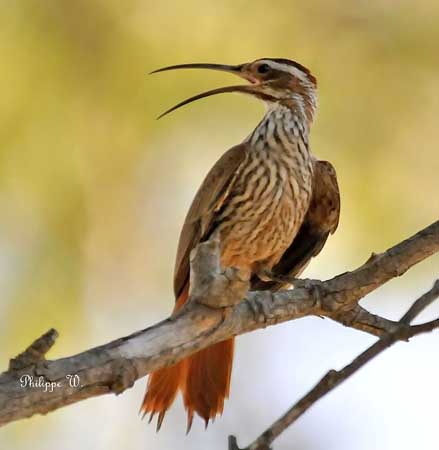
HABITAT:
The Scimitar-billed Woodcreeper frequents mainly Chaco woodland and scrub, also savanna with Proposis and Acacia (espinilho), palm savanna and dry subtropical woodland.
It can be found sometimes at the edges or in gardens and human-altered habitats, and also in open scrub in more arid areas.
This species occurs mainly from lowlands to 600 metres, but it may reach sometimes heights of up to 1000 metres of elevation.
RANGE:
The Scimitar-billed Woodcreeper is resident in its range. It is found in Argentina, SE Bolivia, extreme S Brazil, W Paraguay and W and C Uruguay.
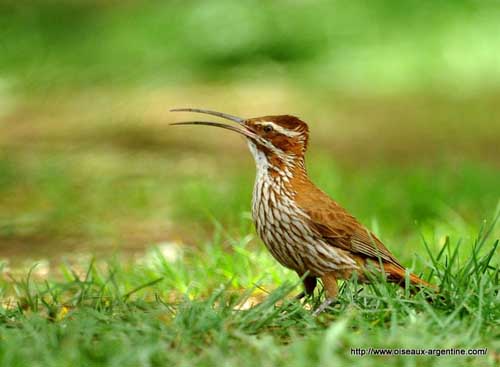
BEHAVIOUR:
The Scimitar-billed Woodcreeper feeds primarily on arthropods and also takes some plant matter.
It forages on the ground in small groups, and often joins mixed-species flocks of Furnaridae. It runs easily on flat surfaces and climbs in trees, vertically on trunks, and perches crosswise on horizontal branches.
Unlike other woodcreepers, it runs on flat ground among the scattered vegetation, and probes into fallen logs, branches, bromeliads and tree cavities. Most preys come from the ground, by probing in soft soils.
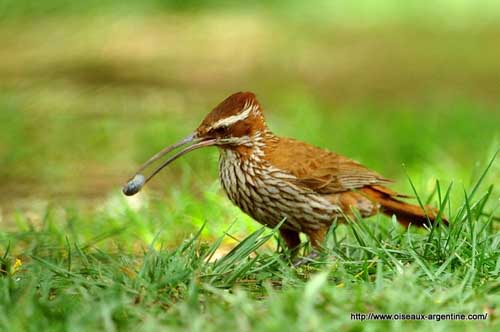
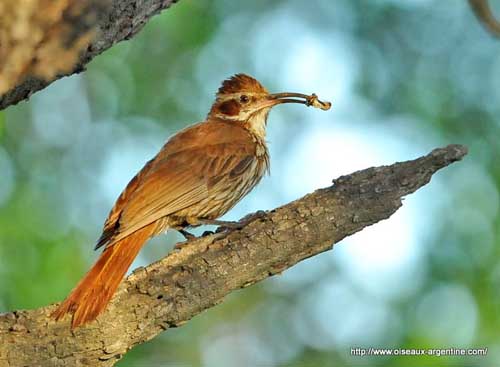
The Scimitar-billed Woodcreeper, as other members of this family, nests in holes, usually an abandoned woodpecker hole, but occasionally, it may nest in an old nest of Rufous Hornero (Furnariius rufus).
Most woodcreepers are territorial, but their aggressive behaviour is usually limited to the close proximity of the feeding flocks.
FLIGHT:
The Scimitar-billed Woodcreeper usually performs undulating flight to nearby trees when disturbed. The flight can be strong, with rapid wingbeats interspersed with glides. When gliding, the tail is spread and the wings outstretched.
REPRODUCTION:
The breeding season occurs from September to November/December.
The Scimitar-billed Woodcreeper often nests in tree cavities, in natural cavities or old hole of woodpecker, and occasionally in abandoned nest of Rufous Hornero, or in unused chimney.
The cavity may reach between 20 and 50 cm in depth, and the entrance is usually at 1, 50 to 2 metres above the ground. There is a lining made with leaves, bark or wood chips.
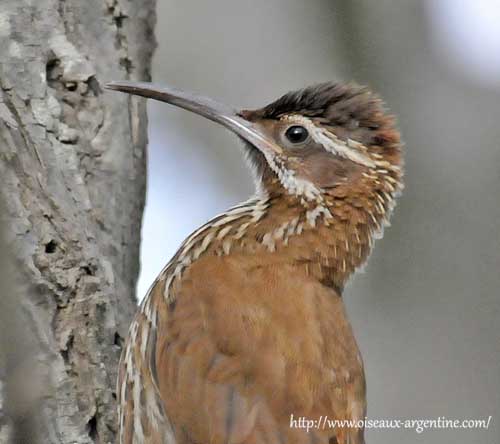
The female lays 3 white eggs, laid on consecutive days. The incubation lasts about two weeks, usually shared by both parents. The female incubates during the night. However, both sexes often share incubation duties equally and brood the chicks.
The young fledge 3 weeks after hatching, and still depend on parents for long period, usually some months.
The Scimitar-billed Woodcreeper has the shortest incubation period with only 14 days.
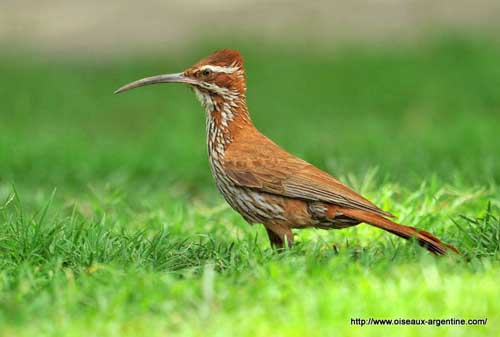
DIET:
The Scimitar-billed Woodcreeper feeds mainly on arthropods, and feeds mostly on spiders. But it also takes centipedes, millipedes, scorpions and other insects such as locusts, caterpillars, beetle’s and ant-lion’s larvae (Myrmeleonidae).
PROTECTION / THREATS / STATUS:
The Scimitar-billed Woodcreeper can be uncommon to fairly common according to the range. Its rarity in some regions is probably due to the lack of suitable habitats.
However, this species is not currently threatened.
